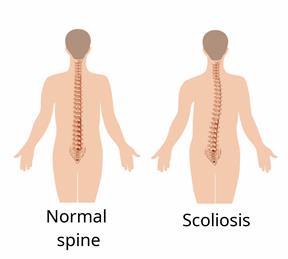Scoliosis

Scoliosis is a condition in which the spine curves sideways. Normally, the spine does not do this. With scoliosis, the spine may curve to the left, to the right, or in both directions. The curve of the spine is measured by angles in degrees.
Scoliosis can affect people at any age, but it is more common among children and adolescents.
What are the causes?
The cause of scoliosis is not always known. It may be caused by:
What are the signs or symptoms?

This condition may not cause any symptoms. If you do have symptoms, they may include:
Leaning to one side.
Sunken chest and uneven shoulders.
One side of the body being different or larger than the other side (asymmetry).
An abnormal curve in the back.
Pain. This may limit physical activity.
Shortness of breath.
Bowel or bladder control problems, such as not knowing when you have to go. This can be a sign of nerve damage.
How is this diagnosed?
This condition is diagnosed based on:
Your medical history.
Your symptoms.
- A physical exam. This may include:
Examining your nerves, muscles, and reflexes (neurological exam).
Testing the movement of your spine (range of motion study).
- Imaging tests, such as:
How is this treated?

Treatment for this condition depends on the severity of your symptoms. Treatment may include:
A back brace to prevent scoliosis from getting worse. This may be needed during times of fast growth (growth spurts), such as during adolescence.
Physical therapy. This involves movements and exercises to strengthen the back.
NSAIDs to help relieve back pain, such as aspirin, ibuprofen, and naproxen.
Surgery.
Follow these instructions at home:
Activity
-
Exercise regularly. Ask your health care provider what activities and exercises are best for you. Keeping your back strong and flexible may help your symptoms and prevent your condition from getting worse.
-
If physical therapy was prescribed, do exercises as told.
-
Maintain good posture.
-
You may have to avoid lifting. Ask your health care provider how much you can safely lift.
-
Before starting any new sport or physical activity, ask your health care provider if it is safe for you.
If you have a removable brace:
-
Wear the brace as told by your health care provider. Remove it only as told by your health care provider.
-
Check the skin around the brace every day. Tell your health care provider about any concerns.
-
Keep the brace clean and dry.
General instructions
-
Take over-the-counter and prescription medicines only as told by your health care provider.
-
Keep all follow-up visits. Your health care provider will monitor your condition over time to watch for signs that it is getting worse and change your treatment plan as needed.
Contact a health care provider if:
-
You lose control of your legs or you cannot walk.
-
You lose control of your bladder or bowels.
-
You develop sudden numbness in the legs.
Summary
-
Scoliosis is a condition in which the spine curves sideways. The spine may curve to the left, to the right, or in both directions.
-
This condition may be caused by birth defects or diseases that affect muscles and body balance.
-
Exercise regularly. Ask your health care provider what activities and exercises are best for you. Keeping your back strong and flexible may help your symptoms and prevent your condition from getting worse.
This information is not intended to replace advice given to you by your health care provider. Make sure you discuss any questions you have with your health care provider.

 This condition may not cause any symptoms. If you do have symptoms, they may include:
This condition may not cause any symptoms. If you do have symptoms, they may include: Treatment for this condition depends on the severity of your symptoms. Treatment may include:
Treatment for this condition depends on the severity of your symptoms. Treatment may include: